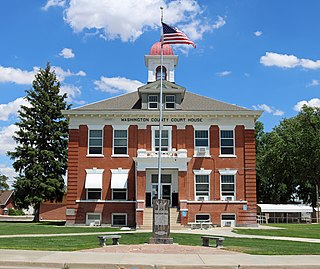
Washington County is a county located in the eastern side of the U.S. state of Colorado. As of the 2020 census, the population was 4,817, making it the least populous “Washington County” in the United States. The county seat is Akron. The county was named in honor of the United States President George Washington.

The City of Louisville is a home rule municipality located in southeastern Boulder County, Colorado, United States. The city population was 21,226 at the 2020 United States Census. Louisville began as a mining community in 1877, experienced a period of labor violence early in the 20th century, and transitioned to a suburban residential community when the mines closed in the 1950s.
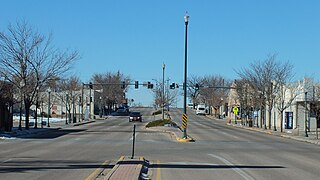
Limon is a statutory town that is the most populous municipality in Lincoln County, Colorado, United States. The population was 2,043 at the 2020 United States Census. Limon lies at the intersection of Interstate 70, U.S. Highways 24, 40, 287, and Colorado Highway 71. The Limon Correctional Facility is part of the Colorado Department of Corrections system and is a major employer in the area with employment of roughly 350.

Fort Morgan is the home rule municipality city that is the county seat and the most populous municipality of Morgan County, Colorado, United States. The city population was 11,597 at the 2020 United States Census. Fort Morgan is the principal city of the Fort Morgan, CO Micropolitan Statistical Area.

Lake George is an unincorporated community and a U.S. Post Office in Park County, Colorado, United States. The Lake George Post Office has the ZIP Code 80827. It lies along U.S. Highway 24 northwest of Colorado Springs, and several miles north of Florissant Fossil Beds National Monument.

Orchard is an unincorporated town, a post office, and a census-designated place (CDP) located in and governed by Morgan County, Colorado, United States. The CDP is a part of the Fort Morgan, CO Micropolitan Statistical Area. The Orchard post office has the ZIP Code 80649. As of the 2020 census, the population of the Orchard CDP was 76.

Snyder is an unincorporated town, a post office, and a census-designated place (CDP) located in and governed by Morgan County, Colorado, United States. The CDP is a part of the Fort Morgan, CO Micropolitan Statistical Area. The Snyder post office has the ZIP Code 80750. As of the 2020 census, the population of the Snyder CDP was 136.
Woodrow is an unincorporated rural hamlet consisting of a U.S. Post Office, a church and 3 houses, located in Washington County, Colorado, United States. The Woodrow Post Office serves ZIP Code 80757.
Thurman is an unincorporated rural hamlet in Washington County, Colorado, United States. It was originally a Mennonite settlement. There are no businesses or services now located in Thurman, and only a couple of farm homes.
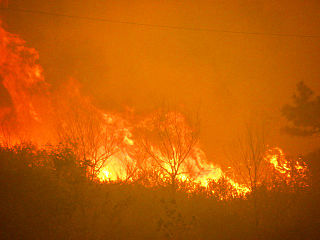
The 2012 Colorado wildfires were an unusually devastating series of Colorado wildfires, including several separate fires that occurred throughout June, July, and August 2012. At least 34,500 residents were evacuated in June.

The North Fire was a wildfire that occurred in the Mojave Desert near the towns of Victorville and Hesperia, north of San Bernardino and south of Bakersfield, California. The fire began on July 17, 2015. The areas most impacted were adjacent to Interstate 15, where the Cajon Pass passes through the San Bernardino National Forest. The fire spread to 4,250 acres, and burned homes and other buildings, as well as numerous vehicles stranded on the interstate. Seventy-four passenger vehicles and trucks were burned along the highway or in neighboring communities due to the fire. The fire closed Interstate 15, the main highway connecting Southern California with Las Vegas, Nevada, during the first day of the blaze.

The San Gabriel Complex Fire was a wildfire that burned in 2016 in the Angeles National Forest, Los Angeles County, California, United States. It was the combination of two separate wildfires: the Reservoir Fire and the Fish Fire, both of which ignited on June 20.

The 2016 Southeastern United States wildfires were a series of wildfires in the Southeastern United States in October and November 2016. The U.S. Forest Service reported tracking 33 wildfires that had burned about 90,000 acres (36,000 ha).

The 416 and Burro Fire Complex were two wildfires that burned in the southwestern portion of Colorado in the United States in 2018. The fires burned predominantly within San Juan National Forest, 13 miles north of Durango and 14 miles south of Rico. The 416 Fire started on June 1, 2018, and the Burro Fire followed on June 8. Federal officials allege that embers emitted from a coal-burning steam locomotive used by the historic Durango and Silverton Narrow Gauge Railroad started the blaze, and have filed a lawsuit against the railroad seeking recoupment of $25 million in firefighting costs, penalties and legal expenses. The fires burned a combined total of over 57,000 acres (23,067 ha) and have cost more than $43 million to contain. On March 31, 2022, the Durango and Silverton Narrow Gauge Railroad reached settlements in two lawsuits stemming from its role in starting the 416 fire: one settlement with federal authorities in which the railroad would pay $20 million to the federal government and institute a fire mitigation program for its operations. In the second settlement, the railroad agreed to pay an undisclosed amount to home and business owners impacted by the fire and subsequent floods during the summer monsoon season that followed in the wake of the 416 fire.

The Spring Creek Fire was a wildfire near Fort Garland and La Veta, Colorado in Costilla and Huerfano counties in southern Colorado. The fire burned a total of 108,045 acres and was the third-largest wildfire in Colorado history.
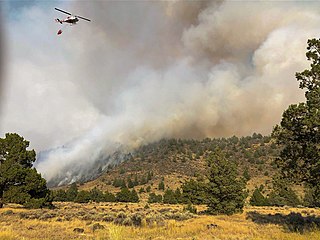
The Tucker Fire was a wildfire that burned near Clear Lake National Wildlife Refuge in Modoc County, California in the United States. The fire ignited on Sunday, July 28, 2019 along Highway 139 and went on to burn an estimated 14,217 acres of land. As of August 15, the fire was 95% contained. Officials say the wildfire was caused by traffic on Highway 139.

The Cameron Peak fire was a wildfire that started near Chambers Lake, Colorado, 25 miles (40 km) east of Walden and 15 miles (24 km) southwest of Red Feather Lakes near Cameron Pass on August 13, 2020, and was declared 100% contained on December 2, 2020. The fire burnt 208,663 acres through the Arapaho and Roosevelt National Forests in Larimer and Jackson Counties and Rocky Mountain National Park. At its peak, the fire forced the evacuation of over 6,000 residents in Estes Park, Chambers Lake, Rustic, Glacier View Meadows, Red Feather Lakes, Masonville, Glen Haven, Spring Canyon, various small communities along Highway 14, Stove Prairie Landing Road, as well as the Colorado State University Mountain Campus and had over 1,000 personnel fighting the fire. 469 structures were destroyed by the fire, including 220 outbuildings and 42 primary residences. The fire became the largest wildfire in Colorado history, surpassing the Pine Gulch Fire, which had set the same mark just seven weeks prior.
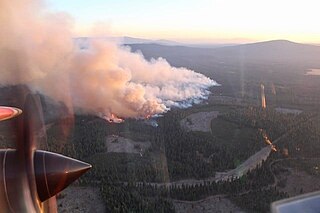
The 2020 Lassen County wildfire season included seven large wildfires that burned entirely or in part in Lassen County. A total of 203,296 acres (82,271 ha) of land was burned in Lassen County, making it one of the larger clusters of fires in the 2020 California wildfire season.

The 2020 Maricopa County wildfires were a series of major and non-major wildfires that took place in Maricopa County, Arizona, from the month of May to the month of October. In the year 2020, Arizona saw one of its worst fire seasons in the states history. Due to the lack of precipitation needed in Arizona, the state fell into an ongoing drought from late 2020 and 2021. High winds were also present during the summer when fire season is mostly active in the state. These factors led to the wildfires in Maricopa County to be destructive and costly.




















